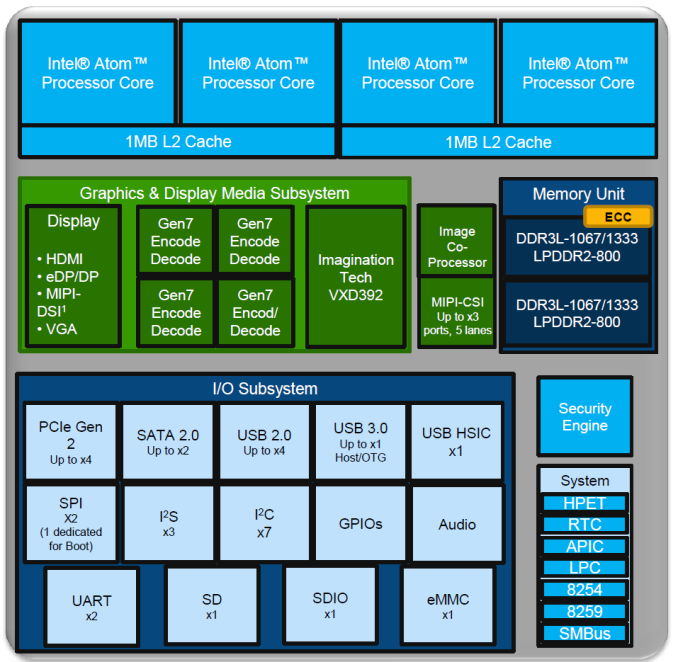ECS LIVA Review: The Nettop Rises Again
by Ganesh T S on July 18, 2014 9:15 AM ESTPlatform Analysis
Previous generation nettops were mostly based on the Atom D525 / Atom D2700 CPUs. In order to make the graphics performance and HTPC aspects attractive, the ION platform was introduced (combining these anemic CPUs with a low-end NVIDIA GPU). Despite the improvements enabled by the GPU in the ION platform, the Atom CPUs held back the performance quite a bit. Intel hardly paid any attention to improving the performance of the CPU cores in the Atom processors, reusing the Bonnell microarchitecture for multiple generations. In the move from 32nm to 22nm, Intel finally realized that the microarchitecture for the Atom lineup needed a major upheaval.
Silvermont into the Picture
The increasing competition from smartphones and tablets made Intel rethink their strategy for the Atom lineup. The ageing Bonnell microarchitecture was replaced by Silvermont, bringing out of order execution and other improvements into the picture. Intel also moved from a PCH-based setup to integrating all the I/O aspects along with the Atom CPU cores into a SoC. With so many code names associated with Silvermont-based products, we thought it would be best to present a bulleted list indicating the markets which Intel hopes to address with each of them.
-
Bay Trail
- Bay Trail-T: Atom Z36xx and Z37xx series for tablets
- Bay Trail-M: Pentium and Celeron branding (N-series) for notebooks and AIOs
- Bay Trail-D: Penitum and Celeron branding (J-series) for desktops
- Bay Trail-I: Atom E38xx for the embedded market
-
Merrifield
- Atom Z34xx: Low-end to mid-range smartphones
-
Moorefield
- Atom Z35xx: Premium smartphones
-
Avoton
- Atom C2xx0: Microservers and cloud storage
-
Rangeley
- Atom C2xx8: Network and communication infrastructure
The various possible components in a Bay Trail SoC are given in the diagram below.
Depending on the target market (as specified in the bulleted list above), some of the components in the above block diagram are cut out. For example, Bay Trail-T does away with the SATA and PCIe lanes. Bay Trail-M is more interesting to us in this article, as the ECS LIVA's Celeron N2806 belongs to that family. It pretty much takes the original Bay Trail configuration as-is.
ECS LIVA - Motherboard Design
The Celeron N2806 used in the ECS LIVA is a 2C/2T solution with a base frequency of 1.6 GHz and a burst speed of 2.0 GHz. With a maximum TDP of 4.5 W and a SDP (scenario design power) of 2.5 W, it is a perfect fit for a passively cooled system. For the purpose of cost-optimization, ECS decided to avoid using the SATA ports. Out of the four PCIe 2.0 lanes, only one is used by the Realtek RTL8168/8111 PCI-E Gigabit Ethernet Adapter. The USB 2.0 and 3.0 ports are used as-is. The eMMC (SDIO0) port is used for storage purposes, while the other SDIO port is used to create the M.2 socket to which the Wi-Fi module is connected.
In effect, ECS has made judicious use of the available I/O to provide consumers with a mix of essential external ports at an optimal price point.











55 Comments
View All Comments
eastcoast_pete - Saturday, July 19, 2014 - link
I second the comments regarding netbooks made here. Trying to do some actual writing on touch screens is a pain, even on larger tablets. I considered Chromebooks , but Google's "required tethering" approach doesn't work for me. I'd love to see MS helping to push a bunch of "Chromebook killers" into the market - Windows netbooks in the $180 - $ 300 price range with the new Baytrail Celerons, 3 or 4 Gb RAM, a 10" -12" high-res screen (no-touch), USB 3 port(s), micro-SXDC slot, and either 64 Gb eMMC 5.0 (lower price point) or 128 Gb SSD (higher). This nettop shows that it could be done. Now, if only MS would see the opportunity and seize it!esgreat - Sunday, July 20, 2014 - link
With max power around 12W and idle power around 4W, I guess I could run this thing at nominal speed with a power bank!Laststop311 - Sunday, July 20, 2014 - link
I personally would rather pay the 800 for the i7-4770r brix system. It must be rough to not have enough money to get the things u want. I don't know how to compromise so news about these systems heavily bores me.AmericanIdle - Friday, August 15, 2014 - link
You were so bored by this story that you felt inspired to leave a comment?The Brix is not fanless, and thus not silent. Also, it uses about 10 times as much power, which matters if you care about the future of the planet. It must be rough to know the price of everything and the value of nothing. I hope you learn how to compromise someday!
Haravikk - Thursday, July 24, 2014 - link
I don't really see the appeal of going so small with so many sacrifices personally, I mean Thin Mini-ITX cases like the Akasa Euler are still tiny machines (about Mac Mini size but a bit taller) and you can put proper desktop processors in them! You can even build a basic dual core system at a very reasonable price. This is why I never liked the idea of a Netbook; they never saved enough money to justify their horrific performance IMO, even when used for nothing but browsing (especially with the increasing demands of modern web content).